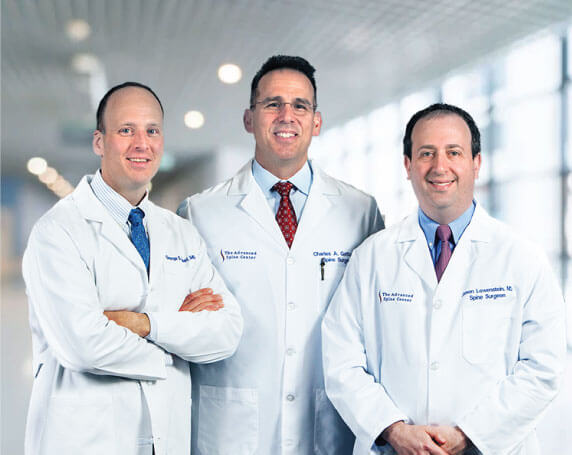Herniated Disc Treatment in New Jersey & New York
Get lasting relief from herniated disc pain with our advanced diagnostics, non-surgical therapies, and minimally invasive treatments.

What is a Herniated Disc?
Your spinal discs are the cushions between your vertebrae that act as shock absorbers for your spine. Each disc has a tough outer layer (annulus) and a soft, gel-like center (nucleus). A herniated disc, also called a ruptured disc, or slipped disc occurs when the outer layer tears or weakens, allowing the inner material to push out and potentially press against nearby nerves.
This herniated disc material can compress nerve roots, causing intense pain that may radiate from your back into your buttocks, legs, arms, or hands, depending on the location of the herniation. The pain can range from a dull ache to excruciating, sharp sensations that make it impossible to sit, stand, walk, or sleep comfortably. Herniated discs most commonly occur in the lumbar spine (lower back) and cervical spine (neck), but can happen anywhere along your spinal column. The condition can develop gradually due to age-related wear and tear, or suddenly from injury or trauma.
Fortunately, herniated or slipped discs are highly treatable. At The Advanced Spine Center, our team of herniated disc doctors use innovative, minimally invasive, and individualized treatment plans to secure relief for thousands of patients with ruptured or herniated discs each year. Patients come to our New Jersey and New York locations from throughout the Northeast, across the nation, and even internationally for the most advanced herniated disc pain relief treatment available.
Herniated Disc Treatment Options
With locations in New York and New Jersey, The Advanced Spine Center offers comprehensive care for herniated discs—ranging from conservative therapies to advanced surgical solutions. Treatment plans are tailored based on the severity of the disc herniation, symptoms, and each patient’s unique needs.
Pain Medication
Non-steroidal or anti-inflammatory drugs can also assist in rehabilitation by relieving pain and enabling you to return to your daily activities while your herniated disc is healing. Epidural injections at the site of the herniated disc can also provide pain relief.
An artificial disc replacement is often recommended to provide pain relief for a herniated disc that occurs in the cervical (neck) region of the spine. During this procedure, your doctor removes and replaces the damaged disc with an artificial model.
A microdiscectomy is a minimally invasive procedure in which your surgeon removes herniated disc material from the site of a ruptured disc. Extracting the contents of a herniated disc allows for the decompression of pinched nerves that are causing painful symptoms.
Physical Therapy
A combination of bed rest and physical therapy is usually the suggested course of action for many patients looking for herniated disc pain relief . A break from strenuous physical activity combined with the strengthening of target muscle groups is often sufficient to alleviate pain.
Herniated Disc Symptoms and Signs
Herniated disc symptoms can vary significantly depending on the location and severity of the disc herniation. Recognizing these symptoms early can dramatically improve treatment outcomes and prevent the condition from becoming chronic.
The most common herniated disc symptoms include sharp, shooting pain that radiates from your back into your arms or legs, burning or electric-like sensations along nerve pathways, and numbness or tingling in your extremities. Many patients also experience muscle weakness in the affected area, pain that worsens with sitting, bending, coughing, or sneezing, difficulty walking or maintaining balance, and loss of reflexes in affected areas.
- Herniated Disc in the Low Back: Lumbar herniated disc symptoms typically involve lower back pain that radiates down your buttock and leg (sciatica), numbness or tingling in your leg or foot, weakness in your leg muscles, and difficulty standing up from a seated position. Many patients find their pain improves when walking or lying down.
- Herniated Disc in the Neck: Cervical herniated disc symptoms commonly include neck pain that radiates into your shoulder, arm, and hand, numbness or tingling in your arm or fingers, weakness in your arm or hand muscles, headaches originating from the neck, and difficulty with fine motor skills.
If you notice any of these herniated disc symptoms, especially if they persist for more than a few days or worsen over time, it’s crucial to consult with a qualified herniated disc diagnosis specialist near you. Early intervention can prevent progression and significantly improve long-term outcomes.
What Our Patients Are Saying
The staff was extremely professional, very accommodating and the doctor was amazing in speaking directly to my daughter to make her understand what was going on and what the plan was. He also took the time to answer her questions. TX dr. Lowenstein!!
-Matt S. ⭐️⭐️⭐️⭐️⭐️
Dr Lowenstein, Jamie and the staff at The Advanced Spine Center are a pleasure, period. During stressful situations, it is a relief to know that a highly competent/caring group of folks are available to assist as necessary with a smile and pleasant demeanor. I maintain 100% confidence in Dr. Lowenstein’s approach to reach a diagnosis, his skill set and bedside manner are above approach.
-Mitchell K. ⭐️⭐️⭐️⭐️⭐️
I found the Advanced Spine Center online and their website explained everything I was going through with nerve pain from collapsed discs in my neck. My phone call to Advanced Spine Center and everyone of the staff members, including Dr. Lowenstein was so helpful and professional. Highly recommend this practice.
-Caroline C. ⭐️⭐️⭐️⭐️⭐️
Minimally Invasive Surgery for Herniated Disc Pain
When herniated disc surgery is necessary, our local herniated disc pain relief experts specialize in minimally invasive techniques that offer significant advantages over traditional open surgery. Our advanced herniated disc surgery approaches provide:
- Smaller Incisions – Reduced scarring and better cosmetic outcomes
- Faster Recovery – Shorter hospital stays and quicker return to activities
- Less Pain – Reduced post-operative discomfort and medication needs
- Better Outcomes – Excellent correction with preserved mobility
At The Advanced Spine Center, our fellowship-trained spine surgeons bring extensive experience in diagnosing and treating herniated discs. Through advanced, personalized care, we’ve helped countless patients overcome pain, restore mobility, and return to the quality of life they deserve.
Why Choose Us for Advanced Spine Care
The Advanced Spine Center in New Jersey is recognized as a leading destination for spine treatment in the nation. Patients choose us for their spine treatment because we offer:

Comprehensive Care
From initial evaluation to post-surgical care, we provide complete spine care. Our multidisciplinary team ensures optimal outcomes for every patient.

Advanced Technology
State-of-the-art imaging, surgical navigation systems, and minimally invasive instruments enable precise, safe spine care with excellent results.

Convenient Location
Easily accessible in New Jersey and New York , our modern facility provides comfortable care in a convenient location. Plus, patients from across the nation, and even world wide, find come to us!
Frequently Asked Questions About Herniated Disc
Herniated discs typically cause sharp, radiating pain that travels from your back into your arms or legs, often accompanied by numbness, tingling, or weakness. The pain may worsen with sitting, bending, or coughing. If you experience these symptoms, especially if they persist or worsen, you should be evaluated by a herniated disc specialist.
Many herniated discs can improve with conservative treatment over 6-12 weeks. However, the disc material that has herniated typically doesn’t return to its original position. While symptoms may improve as inflammation reduces, some cases require intervention to prevent chronic pain and permanent nerve damage.
Surgery may be recommended if severe pain persists after 6-8 weeks of conservative treatment, if you develop progressive weakness or numbness, or if you experience bowel or bladder dysfunction (which requires immediate medical attention). Our herniated disc doctors will thoroughly evaluate your condition to determine if a minimally invasive surgery is appropriate for your specific case.
A bulging disc occurs when the disc extends beyond its normal boundary but the outer layer remains intact. A herniated disc involves a tear in the outer layer, allowing the inner material to leak out. Herniated discs typically cause more severe symptoms and may need more treatment than a bulging disc.
Our team includes fellowship-trained spine surgeons who specialize specifically in disc disorders and minimally invasive techniques. We use the latest diagnostic technology and offer both conservative and advanced surgical options, ensuring each patient receives the most appropriate treatment for their specific herniated disc condition.
Ready to Take the Next Step in Your Spine Care?
Don’t let herniated disc pain limit your life. Contact the leading spinal disc specialists in NJ & NY today!
